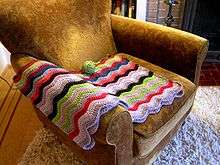Afghan (blanket)

An afghan is a blanket of knitted or crocheted wool.[1] It is sometimes also called a "throw".
"An afghan is the knitted or crocheted wrap that everyone has seen thrown over the back of a rocking chair or folded at the foot of Grandmother's bed. Afghans are often given as gifts and may become family heirlooms. Many people use an afghan as a throw on a chilly day, as a bedspread, or as decoration for the back of a chair. An afghan also makes a good three-season wrap, adding warmth without a lot of weight."[2]
Etymology
The word "afghan" refers to the people of the country of Afghanistan. The coverlet was originally produced by the Afghans. The use of "afghan" in the English language goes back to 1831, when Thomas Carlyle mentioned it in his "Sartor Resartus."[3] The first mention of the word referring to the woven rug was in 1877.[4]
Types and styles
There are three main styles of afghan: mile-a-minute afghans, join-as-you-go afghans, and motif afghans. Mile-a-minute afghans are usually made in one piece and with a minimum of stitches; they are the simplest style to make and are especially popular with beginners. Join as you go afghans are made up of many different pieces, one of which begins where the last leaves off. Motif afghans, such as the granny square, are composed of many different small pieces, called motifs, squares, or blocks. These motifs may be all of the same design or of different designs, but they are typically the same size, for ease of joining. Some favor the motif style because of its portability and versatility of design. The motif style is still a very popular and a complex design for making blankets, scarves, etc.
References
- ↑ http://www.oxforddictionaries.com/us/definition/american_english/Afghan
- ↑ http://www.wisegeek.com/what-is-an-afghan.htm
- ↑ "Sartor Resartus", Fraser's Mag. VIII 670/1 Afghaun shawls, Thomas Carlyle, 1833
- ↑ "Life and Letters of Elizabeth Prentiss", pp. 260, Letter: 13 Dec., 1868. Elizabeth Prentiss, George Lewis Prentiss, 1882.